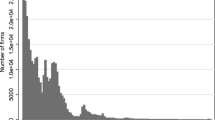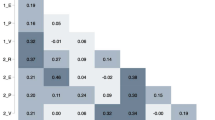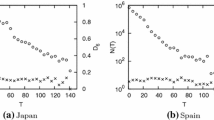Abstract
In Japan, we observed rapid power law growth in the first 10 years of the existence of firms and subsequent slow exponential growth on their ages not only in their sales but also in their number of employees. We also confirmed similar long-term properties in France. These observations were found by employing around one million bits of exhaustive financial data of firms in Japan and France from 2004 to 2013. Comparing the parameters, the power law and exponential growth indices of sales are larger than those of the number of employees. Such long-term growth is derived from non-Gibrat’s law in the middle-scale range and Gibrat’s law in the large-scale range. We observed both non-Gibrat’s law and Gibrat’s law, which denotes the dependence of the growth rate distributions on the initial values, for two successive years in the short-term. By introducing a stochastic model based on the short-term laws, we showed that non-Gibrat’s law and Gibrat’s law lead to power law growth and the subsequent exponential growth, respectively.








Similar content being viewed by others
References
Aoyama H, Nagahara Y, Okazaki MP, Souma W, Takayasu H, Takayasu M (2000) Pareto’s law for income of individuals and debt of bankrupt companies. Fractals 8:293–300
Axtell RL (2001) Zipf distribution of US firm sizes. Science 293:1818–1820
Bonabeau E, Dagorn L (1995) Possible universality in the size distribution of fish schools. Phys Rev E 51:R5220–R5223
Bottazzi G, Secchi A, Tamagni F (2008) Productivity, profitability and financial performance. Ind Corp Change 17:711–751
Bureau van Dijk. http://www.bvdinfo.com/
Clauset A, Shalizi CR, Newman MEJ (2009) Power-law distributions in empirical data. SIAM Rev 51:661–703
Coad A (2010) The exponential age distribution and the pareto firm size distribution. J Ind Compet Trade 10:389–395
Coad A (2010) Investigating the exponential age distribution of firms. Economics 4:2010–2017
Coad A (2009) The growth of firms. Edward Elgar Publishing, USA
Fu D, Pammolli F, Buldyrev SV, Riccaboni M, Matia K, Yamasaki K, Stanley HE (2005) The growth of business firms: theoretical framework and empirical evidence. Proc Natl Acad Sci 102:18801–18806
Fujiwara Y (2004) Zipf law in firms bankruptcy. Phys A 337:219–230
Fujiwara Y, Aoyama H (2010) Large-scale structure of a nation-wide production network. Eur Phys J B 77:565–580
Fujiwara Y, Guilmi CD, Aoyama H, Gallegati M, Souma W (2004) Do Pareto-Zipf and Gibrat laws hold true? An analysis with European firms. Phys A 335:197–216
Fujiwara Y, Souma W, Aoyama H, Kaizoji T, Aoki M (2003) Growth and fluctuations of personal income. Phys A 321:598–604
Gibra R (1932) Les Inégalités Économique. Sirey, Paris
Gopikrishnan P, Meyer M, Amaral LAN, Stanley HE (1998) Inverse cubic law for the distribution of stock price variations. Eur Phys J B 3:139–140
Ishikawa A (2006) Annual change of Pareto index dynamically deduced from the law of detailed quasi-balance. Phys A 371:525–535
Ishikawa A (2006) Derivation of the distribution from extended Gibrat’s law. Phys A 367:425–434
Ishikawa A (2007) The uniqueness of firm size distribution function from tent-shaped growth rate distribution. Phys A 383:79–84
Ishikawa A (2009) Quasistatically varying log-normal distribution in the middle scale region of Japanese land prices. Prog Theor Phys Suppl 179:103–113
Ishikawa A, Fujimoto S, Mizuno T (2011) Shape of growth rate distribution determines the type of non-Gibrat’s property. Phys A 390:4273–4285
Ishikawa A, Fujimoto S, Mizuno T, Watanabe T (2016) Firm growth function and extended-gibrat’s property. Adv Math Phys 2016:9303480
Ishikawa A, Fujimoto S, Mizuno T, Watanabe T (2015) Firm age distributions and the decay rate of firm activities. In: Takayasu H, Ito N, Noda I, Takayasu M (eds) Proceedings of the international conference on social modeling and simulation, plus econophysics colloquium 2014, pp 187–194
Ishikawa A, Fujimoto S, Mizuno T, Watanabe T (2015) The relation between firm age distributions and the decay rate of firm activities in the United States and Japan, Big Data (Big Data). In: 2015 IEEE international conference on date of conference, pp 2726–2731
Iyetomi H, Aoyama H, Fujiwara Y, Ikeda Y, Souma W (2012) A paradigm shift from production function to production copula: statistical description of production activity of firms. Quant Financ 12:1453–1466
Levy M, Solomon S (1996) Power laws are logarithmic Boltzmann laws. Int J Mod Phys C 7:595–601
Luttmer EGJ (2011) On the mechanics of firm growth. Rev Econ Stud 78:1042–1068
Mantegna RN, Stanley HE (1991) Introduction to econophysics: correlations and complexity in finance. Clarendon Press, Oxford
Mantegna RN, Stanley HE (1995) Scaling behavior in the dynamics of an economic index. Nature 376:46–49
Matia K, Fu D, Buldyrev SV, Pammolli F, Riccaboni M, Stanley HE (2004) Statistical properties of business firms structure and growth. Europhys Lett 67:498–503
Miura W, Takayasu H, Takayasu M (2012) Effect of coagulation of nodes in an evolving complex network. Phys Rev Lett 108:168701
Mizuno T, Katori M, Takayasu H, Takayasu M (2002) Statistical laws in the income of Japanese companies, empirical science of financial fluctuations. Springer, Tokyo, pp 321–330
Mizuno T, Souma W, Watanabe T (2014) The structure and evolution of buyer-supplier networks. PLOS One 9(7):e100712
Newman MEJ (2005) Power laws. Pareto distributions and Zipf’s law. Contemp Phys 46:323–351
Nirei M, Souma W (2007) A two factor model of income distribution dynamics. Review of Income and Wealth 53:440–459
Okuyama K, Takayasu M, Takayasu H (1999) Zipf’s law in income distribution of companies. Phys A 269:125–131
Pareto V (1897) Cours d’Économie Politiqu. Macmillan, London
Petersen AM, Riccaboni M, Stanley HE, Pammolli F (2012) Persistence and uncertainty in the academic career. Proc Natl Acad Sci 109:5213–5218
Podobnik B, Horvatic D, Pammolli F, Wang F, Stanley HE, Grosse I (2008) Size-dependent standard deviation for growth rates: empirical results and theoretical modeling. Phys Rev E 77:056102
Podobnik B, Horvatic D, Petersen AM, Urošević B, Stanley HE (2010) Bankruptcy risk model and empirical tests. Proc Natl Acad Sci 107:18325–18330
Render S (1998) How popular is your paper? An empirical study of the citation distribution. Eur Phys J B 4:131–134
Romer PM (2008) Economic growth. In: Henderson DR (ed) The concise encyclopedia of economics. Liberty Fund, Indianapolis
Saichev A, Malevergne Y, Sornette D (2009) Theory of Zip’s law and beyond. Cambridge University Press, Cambridge
Solow R (1956) A contribution to the theory of economic growth. Q J Econ 70:65–94
Sornette D, Cont R (1997) Convergent multiplicative processes repelled from zero: power laws and truncated power laws. J Phys I(7):431–444
Statistics Bureau, Ministry of internal affairs and communications. http://www.stat.go.jp/index.htm
Sutton J (1997) Gibrat’s legacy. J Econ Lit 35:40–59
Takayasu H, Sato A, Takayasu M (1997) Stable infinite variance fluctuations in randomly amplified Langevin system. Phys Rev Lett 79:966–969
Takayasu H, Sato A, Takayasu M (1997) Stable infinite variance fluctuations in randomly amplified Langevin systems. Phys Rev Lett 79:966–969
Tomoyose M, Fujimoto S, Ishikawa A (2009) Non-Gibrat’s law in the middle scale region. Prog Theor Phys Suppl 179:114–122
Yamano T (2004) Distribution of the Japanese posted land price and the generalized entropy. Eur Phys J B 38:665–669
Acknowledgments
The authors thank the Yukawa Institute for Theoretical Physics at Kyoto University. Discussions during the YITP workshop YITP-W-15-15 on “Econophysics 2015” were useful to complete this work. This study was supported by JSPS KAKENHI Grants Numbers 24510212 and 24710156.
Author information
Authors and Affiliations
Corresponding author
Ethics declarations
Conflict of interest
The authors declare that there is no conflict of interest regarding the publication of this article.
About this article
Cite this article
Ishikawa, A., Fujimoto, S., Mizuno, T. et al. Long-term firm growth properties derived from short-term laws of sales and number of employees in Japan and France. Evolut Inst Econ Rev 13, 409–422 (2016). https://doi.org/10.1007/s40844-016-0055-0
Published:
Issue Date:
DOI: https://doi.org/10.1007/s40844-016-0055-0




